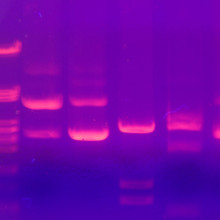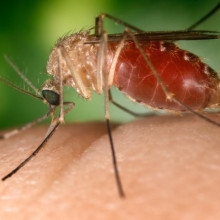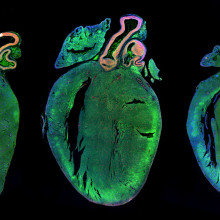Our genes are our unique calling card, and DNA analysis has been used to solve crimes and resolve paternity disputes for decades. Now new genetic technology promises to revolutionise medicine. Plus, we meet the man who invented genetic fingerprinting, discuss Angelina Jolie's breasts, and savour a cheesy gene of the month.
In this episode

01:04 - Prof Alec Jeffreys - DNA fingerprinting
Prof Alec Jeffreys - DNA fingerprinting
with Professor Sire Alec Jeffreys
Kat - Back in April I was at the Royal Society in London for the Genetics Society Spring meeting, Genomics for Health and Society. One of the most captivating talks of the day was from Professor Sir Alec Jeffreys, the inventor of DNA fingerprinting in the 1980s. It was initially used to resolve immigration disputes, proving whether people were really family members or not, and paternity disputes, then rapidly transformed crime detection. I asked him where he thought DNA fingerprinting technology is heading in the future.
Alec - Well, I think in terms of the technology we have at the moment, we're sort of trapped in a technology track using technology which is now round about 20 years old. Now, we don't see that evolving a great deal certainly in crime detection. But I what I do see is broadening out into - if you think about DNA identification family relationships, your initial thoughts for catching the criminal, working out whether so and so was really the father of the child. What's now emerging is much broader fields of DNA and genealogy and ancestry, and that sort of become pretty mature field but it's got a long way to go yet.
So, the question is, to what extent can we discover interesting things about your ancestry by scouring through your DNA sequences, comparing them with other individuals? So, just as a hypothetical, let's suppose that we could take every single person in the United Kingdom, and sequence their entire genome. You could take that information, and go a very long way towards establishing an incredibly detailed family tree of all the peoples of Britain. A detailed genealogy and just imagine what you could do with that. All these long lost third cousins you knew nothing about, all sorts of interesting connections with physical characteristics - you might have their facial features and all the rest of it.
Kat - My mum would love this!
Alec - So, I think the potential is there. It does raise very thorny issues with genetic privacy and so on. I mean, as soon as you start looking at the genome, yes, you'll come up with a lot of DNA variation which is informative in terms of ancestry, but not particularly important in terms of you as an individual. But amongst that is going to be all sorts of potentially quite nasty surprises. Mutations within your DNA that may well have health consequences. So, tread carefully, interesting field, but there's a downside there potentially.
Kat - And thinking more about crime and forensics, now that we can do whole genome analysis and we start to know what sort of genes encode for variations in characteristics, do you think maybe in the future, police will be able to reconstruct what a criminal will look like from just a sample of their DNA?
Alec - Yeah, that is something that people, certainly, the police and scientists associated with forensics science, they've been interested actually with that over two decades and this notion of the DNA identikits. So, can you go into DNA, what sort of physical characteristics can you predict from that? And at least at the moment, it's fairly limited so we can do the sex of an individual. Red hair, there's a good test for that, eye colour can be done, other things like facial features which is perhaps the most direct side of heritability that we all think about. You know, little Jimmy's got his mum's eyes and his dad's nose. Those are statements that do make sense. We can see heritability of facial features, can you actually detect the DNA determinants that control the way we look. Barely off the starting block and it may well be that it turns out to be so genetically complex. You can never use it in a simple predictive forensic context. But I would make the argument that the reason for doing that is not for police investigation. It's just that most fascinating area of inquiry and that is, what makes us all unique.
Kat - Why am I me?
Alec - Yeah, why are you you and why do you look the way you do, and how does DNA influence that uniqueness as an individual? So, I would see the future of forensic DNA very much as forensic DNA as part of a much bigger set of DNA inquiries which revolve around the individual - who I am as an individual, how the DNA contributes to that.
Kat - And now that we have more and more DNA sequences and much more genomic information about more and more people, do you have any concerns about how this information might be used for example by the police or by the state, or by other individuals?
Alec - Well, I mean a full genome sequence will by definition include all the information on all the genetic variants that are potentially damaging to you as an individual. So, there are issues of genetic privacy there and the rights for either the National Health Service or government, whatever, to having information, highly personal private information of for instance disease liabilities. But remember the information on your genome has implications for other people. So, your genome isn't your genome. Your genome is half of your mum and half of your dad's genome. If you've got children, each of those will have been inherited half of it. So, the genome is a shared thing and anything that you find out about your genome has immediate implications for close family relatives. And again, that's all too often forgotten in this notion of personalised medicine that genomic information, helping you as an individual optimise your treatments or whatever which is fine. But remember the level of the genome, it's just not you and all these relatives as well.
Kat - When you first came up with the idea of genetic fingerprinting back in the '80s, did you have any idea how that field would grow and just how the field of genetics and genomics would explode?
Alec - No way. I mean, I saw - when we first came up with the notion of the DNA identification, sort of the day one, potentially, of utility in let's say in forensic investigations, but a technology of last resort. So, if you were to tell me that today, there's well over 20 million convicted criminals now have their DNA profile database on national DNA databases for the total number of people worldwide that through criminal investigations, through paternities, through immigration case work, and so on have been - their lives have been directly affected by DNA tests. Do we have a number? I don't know. Nobody is counting - 30, 40 million. I have absolutely no idea, possibly more. I mean, I would never have believed that. So, it really has - I mean, the way it's spread and spread so rapidly is quite extraordinary. I remember certainly in the early days, the driver for that spread was the community itself. It wasn't government departments. It wasn't the police. It wasn't the lawyers insisting on this. It was the families themselves trapped in disputes who suddenly saw DNA as the salvation.
Kat - And then it's amazing to think that maybe the driver of the next genetic revolution could be people like my mum doing their family history.
Alec - Oh, yes and that is quite likely. I'm fairly sure that the genealogy, people doing family history is already a bit of a driver and this will become a much larger driver in the future. I mean, I haven't had my genome done. I'll be a bit leery about having it done so, I'd discover all the genetic nastinesses that are sort of lurking in my chromosomes, but I would love to have it done for genealogy. One specific question which is sort of been attempted already but I don't think the answer is definitive is, I'm a Welsh Jeffreys, so is Judge Jeffreys, Baron George Jeffreys, the hanging judge. So, maybe I'm a descendant of his. Let's use DNA to find out.
Kat - That was Alec Jeffreys from the University of Leicester.

09:02 - Angelina Jolie and genetic testing
Angelina Jolie and genetic testing
with Matt Kaiser
Kat - Now, the big story this month has been Angelina Jolie - genetics finally hitting the headlines. She announced in a very moving article in the New York Times that she'd had a double mastectomy after learning that she had an apparently 87 per cent chance of developing breast cancer and this is because she carries a faulty BRCA1 gene and she does seem to have some family history of this. I mean, it's quite a big decision to make, isn't it?
Matt - Yeah, absolutely. I mean, as we know, her mother died of ovarian cancer and since then we've learned that her mother's sister, so her aunt, also unfortunately died of cancer. So, it was obviously a very, very difficult decision for her in having that test and being put to high risk of developing breast cancer and ovarian cancer.
Kat - And the figure of 87 per cent, it seems remarkably precise, but I'm guessing there's some kind of computer programme that they've put all sorts of things into.
Matt - Yes, absolutely. I mean, the BRCA11 mutation can increase the lifetime risk for women between 60 and 90 per cent which is quite a broad range.
Kat - That's for breast cancer, isn't it?
Matt - For breast cancer, yes and 40 to 60 per cent for ovarian cancer. The 87 per cent figure comes from sciences working out lots of other different risk factors, so other genetic factors, the particular type of mutation that a person might have - age, environment, and lifestyle factors. So, all these stuff gets thrown into a computer programme and out comes the number of 8 per cent and it sounds so precise, but it's probably not quite as accurate as it first seems.
Kat - I mean, but it is basically very high. I think the average risk for women in the general population is about a 12 per cent chance in your lifetime. So that's, if there are 100 women, 12 of them would get breast cancer at some point whereas this is, we're talking about even up to 80 to 90 per cent risk. So, it is very significant, but there's a wider context here as well because currently, the BRCA1 and BRCA2 - these are breast and ovarian cancer genes - there's a big patent case going on in the US right now and we should be hopefully quite soon expecting an answer on this. What is this case about that?
Matt - Yes, it's a really interesting one. So, there's a company called Myriad Genetics who developed a diagnostic test and this tests for the mutations in BRCA1 and the BRCA2 genes which we know increase the risk of breast and ovarian cancer. Now, they own a patent that was granted in the US for that test and what's interesting is that patent also covers the whole gene as well. So, rather than just the test they can sell, they actually own a patent on the gene which can actually prevent people from working on the gene and developing their own tests. So, they have a bit of a monopoly on this testing for these mutations. Now, to gain a patent, you have to show that there has been some invention and you could argue and perhaps quite sensibly that a gene is not an invention. It's come about by an evolutionary process. It happens in nature.
Kat - And also, everyone's genes are slightly different too.
Matt - Exactly, yes. So, how can you pattern a gene? They claim this when they take out of someone's cells and they break it up and put into their genetic test, that creates a new entity, and that's their invention, and that's where they're patent lies. But it's a bit of a grey area.
Kat - It's a very interesting issue because it is basically who owns your genes on the right to test for them because the BRCA1 and 2 tests are very, very expensive. They're several thousand dollars, I understand, whereas now, the cost of genetic sequencing and genetic testing should be coming right down. I think it could be a landmark case.
Matt - Absolutely. I mean, because they own this monopoly, they can charge vast sums of money and that could prevent some women having access to the test for something that could be done for maybe a couple of hundred dollars. And we'd also wouldn't want researchers who are looking at alternative ways, cheaper ways, perhaps there's new discoveries to be made on the BRCA1 mutation. So, it's really important that doesn't happen.

13:19 - Mutant mosquitoes don't smell
Mutant mosquitoes don't smell
with Matt Kaiser
Kat - And finally, I just wanted to wrap up with a completely different story which is about mutant mosquitoes and the headline being, mutant mosquitoes don't smell. What's this story about?
Matt - OK, so this is a research that was covered by Leslie Vosshall who's a Neurobiologist at Rockefeller University in New York. Her lab a few years ago was studying Drosophila.
Kat - These are little fruit flies.
Matt - These are little fruit flies which have been the standard lab tool for geneticists for a good century and they're really easy to study genetically and to modify, and to look at how genetic modifications change their behaviour. They were able to genetically modify some fruit flies that lost their sense of smell and they did this by mutating a single gene that makes a protein that forms a complex with all the smell receptors in the Drosophila's antennae, their version of their nose. Without this co-receptor, the smell receptors don't form a functioning protein. Now, they've been able to translate this research into mosquitoes, into the mosquito Aedes aegypti which is the mosquito that carries dengue and yellow fever. They showed that they were able to genetically modify this protein in the mosquito as well. The interesting thing then was that the mutant mosquitoes weren't able to discriminate between humans and guinea pigs which normally mosquitoes will be able to do.
Kat - Bad news for the guinea pigs.
Matt - Absolutely, so as to feel the guinea pigs' pain, there's also a human experiment in which Professor Vosshall volunteered herself to take part in this, which was to offer the mutant mosquitoes a normal human arm, and one that's been slathered in DEET which is the component of many insect repellents, what was interesting was the mutant mosquitoes weren't repelled by DEET, which is what normal mosquitoes would be.
Kat - It was interesting as well because they couldn't tell the difference between an arm that smelled of DEET and one that didn't, but when they got onto the arm, they really didn't like it and they went away. So, maybe DEET is having another effect that's not just smell too.
Matt - Yes, so rather than carrying on and feeding, and they did - they were eventually repulsed when they were actually in direct contact. So, perhaps to do the taste pathway, this is building her body of knowledge and it could really help with some new generation of insect repellents, and it's worth pointing out that this protein is present called Orco which is the co-receptor, it's found in all insects as well, so it could be transferred to other disease carrying insects. I just think it's a great example of how playing about with fruit flies and studying their genes, and perhaps that's seen as something that doesn't have much of an endpoint. It can be translated and now, we're really seeing the fruits of that fundamental knowledge.

16:09 - Hole in the heart gene found
Hole in the heart gene found
An international team led by researchers at the Universities of Manchester and Newcastle have tracked down a gene fault linked to a type of heart defect in newborn babies known as "a hole in the heart". Writing in the journal Nature Genetics, the researchers scanned through 500,000 genetic variations in more than 2,000 patients born with congenital heart defects, and compared them with the same variations in more than 5,000 healthy people. They discovered that a particular variation near a gene called Msx1 was found in around ten per cent of people born with a hole in the heart - a condition known as an atrial septal defect, which is one of the most common forms of congenital heart disease. It's not exactly clear whether Msx1 itself is responsible, but the team are now trying to figure that out.

16:54 - Motor neurone disease mutations
Motor neurone disease mutations
US researchers have discovered a number of new gene faults linked to spontaneous, non-inherited cases of a particular type of motor neuron disease known as amyotrophic lateral sclerosis, ALS, or Lou Gehrig's disease, an incurable disease where the nerves responsible for movement and breathing stop working. Although some of the gene faults responsible for hereditary ALS are known about, more than nine in ten cases happen in people with no family history, and there's no way of telling who might be at risk.
Publishing in the journal Nature Neuroscience, the scientists compared DNA from 47 patients with spontaneous, or sporadic, ALS with DNA from their parents who were unaffected. They were looking for new gene faults that had arisen within the patient that weren't present in either parent. They discovered 25 new gene faults that had arisen in the patients, including five faults in genes involved in packing DNA up within the cell to form a structure called chromatin, providing new insights into what might be causing the disease.

18:10 - Prof John Burn - New genetic frontiers
Prof John Burn - New genetic frontiers
with Professor Sir John Burn, University of Newcastle
Kat - But now it's time to hear more from the Genetics Society Spring Meeting. Perhaps the most futuristic talk came from Professor Sir John Burn, from the University of Newcastle, who talked about the latest developments in bringing gene technology directly to patients' bedsides - something that could revolutionise medical care in the not-too-distant future. It turns out that a handheld gene scanning device - not too dissimilar from Mr Spock's fictional tricorder - may not be too far away. I asked him explain more about the exciting developments in technology, and what the future of genetic analysis might look like.
John - We're seeing, I think, a diversity of delivery. There's been a lot of emphasis on whole genome sequencing and looking at all your genes in one go and that's clearly part of the story and the machinery for that is getting even more powerful but also, point of care testing. There are a lot of situations - infection diagnosis, pharmacogenetics in people being prescribed drugs where you might just want to do a test here and now, and a very specific test targeted to a particular purpose.
Kat - So, just a couple of genes, not the whole lot.
John - Yeah, exactly and it takes a lot of issues about protecting your data and so on. I mean, you could reliably give that to a much more diverse populations of clinicians like pharmacists and GPs because they're not asking for genome questions. They're just asking the question they need an answer to for this particular circumstances. I'm currently in a debate and I'm obviously bias because the company I'm part of has now got a very powerful point of care technology which is using nanowires. On that basis, you end up testing a yes, no sort of question - is this or is this not present? And then from there, we're moving on to sequence short runs of DNA and we think we can actually take that to the next level, and actually sequence whole stretches of DNA by using nano channels lined with nano wires. So, it's actually very exciting because it means we actually can really now see the prospect in our gadget - the first of which arrive next month - of doing sort of 20 tests for 20 pounds in 20 minutes, which changes the whole game in terms of point of care testing.
Kat - So, just to get an idea of this kind of technology, what sort of scale are we talking about - the size of a microwave, the size of a phone? What's the future going to look like for these kind of point of care genetic tests?
John - There are lots of machines around and they vary in size and complexity. The one that we're working with, QuantumDX, we have our first machine that looks like a big old fashioned computer or a microwave is a good comparison. But that's actually because we're still playing with the constituents. By the end of this year, we'll have something that will be with a screen about the size of an iPad that's easily portable.
Kat - So, a laptop kind of size.
John - Yeah, sort of a laptop size but a bit deeper. But in fact, our intention is to end up with what you might call the sort of overinflated iPhone which would actually be able to take a cassette plugged in the top and the cassette carries all of the necessary DNA extraction amplification and testing chemicals. So, the same little machine will give you a test for TB or a test for drug sensitivity, or test a tumour sample, depending on what the question is you need answered. And that's actually within sight in the next couple of years.
Kat - Because that sounds like something science fiction. You put a bit of someone's blood in this little device and it tells you, they need this drug and not that drug, they've got this infection, not that infection. Does it kind of stagger you when you look back over your career that we've got to this point so fast?
John - Absolutely. I mean yes, in fact, we've talked to the people in America who are trying to make the tricorder which was of course what Captain Kirk used or Mr Spock used. In fact, Captain Kirk used captain's log on a pad, so the name iPad actually was derived from that era. And yes, I think the tricorder is getting closer. I mean, the idea that you can spit in the end of the machine and for next or nothing in no time, know the DNA result was unimaginable. I mean, when I started genetics, we can do any DNA tests. I actually pre-date the DNA era which is quite scary.
So, I think we've got to keep changing our perception. DNA was sort of a hypothetical concept when I started then it became something very few people could do, then it became dramatically more accessible but still, big technology driven by people who are very clever and not part of the common sort of routine clinical practice. What we're now moving into is that period where it sort of disappears in a way. Our iPhones and our smartphones have got enormously powerful computers, but we don't think of them as enormously powerful computers - it's just a phone. And I think sequencing in DNA will just be a test. It will just be a part of our routine practice and I think that's where we're at now. I think that's where we're at now. I think it's going to become completely ubiquitous at certainly in terms of these simple tests. And potentially of course, if we get 100,000 genome project to work in our medical records, we'll carry a whole host of the useful information in a few years' time that will help us get more personalised care.
Kat - And where do you see are the really potential big wins that could come quite quickly from getting more genome sequencing technology available in the clinic in the UK?
John - I think that we shouldn't be underestimating the logistical challenge of understanding complex traits because there's so much we don't know about the genome in terms of noncoding RNAs, epigenetics and so on. There are genes being switched on and off by environmental factors. So, I want to concentrate on areas for example with hereditary breast cancer, hereditary bowel cancer, familial hypercholesterolemia, where we've got those three conditions in England or in the UK. There are about a third of a million people carrying genes, high penetrance genes, and in each case, we have a very effective intervention that could reduce or avoid them developing cancer. The one I'm obviously most interested in is colon cancer because we've shown that 2 aspirins a day will half - you're a cancer risk if you've got hereditary cancer [genes] and that's a very cheap treatment. But there are 60,000 people out there in Britain based on the best evidence and we only know 6,000 of them. So, we've got to find those people and that's where I think there's going to be a major development in the near future. But once we proved it worked for them where the ethics is clear, the research is encouraged by the patient group, we can roll it out into a bigger population. And 5 years from now, I think all genome sequencing is a sort of fairly routine thing that if you turn up with a medical problem. It's entirely within vision.
Kat - That was John Burn, from the University of Newcastle and the company QuantuMDX

How is skin colour controlled by genes?
Kat - Now it's time to look at your burning genetics questions, with the help of Naked Scientist Martha Henriques.
Martha - Listener Catherine Wells wanted to know about the genetics underlying differences in human skin colour. Why is it that children often have an intermediate appearance between their two parents? Mircea Iliescu from Cambridge University explained.
Mircea - Skin pigmentation is given by melanin, so melanin is a pigment which is in the skin cells. Melanin is produced in these granules in the cells which are melanosomes and this is quite a complex process of probably more than a hundred proteins and genes that are involved in producing this pigment. And so, the pigmentation eventually depends on the type of melanin, on the amount of these granules of melanin, and on the distribution of the granules in the skin. All these affects how dark or light the skin would be. These days, we measure for example with a melanin index, so we have a reflectometer machine which can measure skin reflectance - so, how light or dark the skin is and it gives us some melanin index of value. For example, the range can be let's say, from 25 to 100 where 25 would be a European skin and 100 would be someone in equatorial Africa. So, because we have a complex process and because there's a high range of variations, it is highly unlikely that one gene only, one change in one gene would cause all these difference like it happens with eye colour from blue to brown, and changes in several genes can alter the pigmentation values. So, just to give you an example, the gene which probably has the most effect is slc2485 which has an effect of about 10, 15 melanin index units. That's the most one gene can impact pigmentation and that is usually in an additive manner. So, if you have two copies of this gene, one change would maybe give it - create a difference of 5 melanin index units and the second copy, as it changes, gives you another 5 or 6. So, it's not really dominant like it happens with blue and brown eyes where if you have only then one copy of the brown gene let's call it, you'll get instantly brown eyes. And so, this process, there's a combinatorial effect of all these genes, each with their own effect and depending on what the parents have then the kid will have an intermediate range and it could have darker or lighter skin. That's how basically the range of pigmentation in the world is created.
Martha - So, a large number of genes contribute to human skin colour in a number of different ways which results in a subtle and complicated process influencing the child's skin colour. Thanks to Mircea Iliescu for answering that question from Catherine Wells.
Kat - If you've got any questions about genes, DNA and genetics you'd like us to answer, just email them to genetics@thenakedscientists.com, tweet us @nakedgenetics or post on our Facebook page

27:47 - Gene of the month - Swiss Cheese
Gene of the month - Swiss Cheese
with Kat Arney
And finally, our gene of the month is Swiss Cheese. As regular listeners might have come to expect, Swiss Cheese is the name of a gene mutation in fruit flies, first described in 1979. The flies start out life just fine as larvae, but then their nerve cells start to break down in the pupa and adult stages. Adult flies with a faulty Swiss Cheese gene have a characteristic pattern of holes in their brains, like their namesake food. Researchers now know that the protein encoded by Swiss Cheese is involved in controlling how supporting cells, called glial cells, wrap around nerve cells to protect them. In mutant flies, the glial cells are overactive, wrapping round the nerve cells too much and causing them to die.
There's a similar protein in yeast and worms, and also in mammals, where it's known as neuropathy target esterase, or NTE. Getting rid of this protein in the brain of mice leads to a similar holey appearance as in the flies, while mice lacking the gene altogether die in the womb as the placenta doesn't form properly. In humans, faults in NTE are responsible for a type of hereditary motor neurone disease, and it's also the main target of organophosphate pesticide chemicals. But the actual function of Swiss Cheese, or NTE, still needs to be completely figured out, and researchers are working to fill in the, err, holes.










Comments
Add a comment